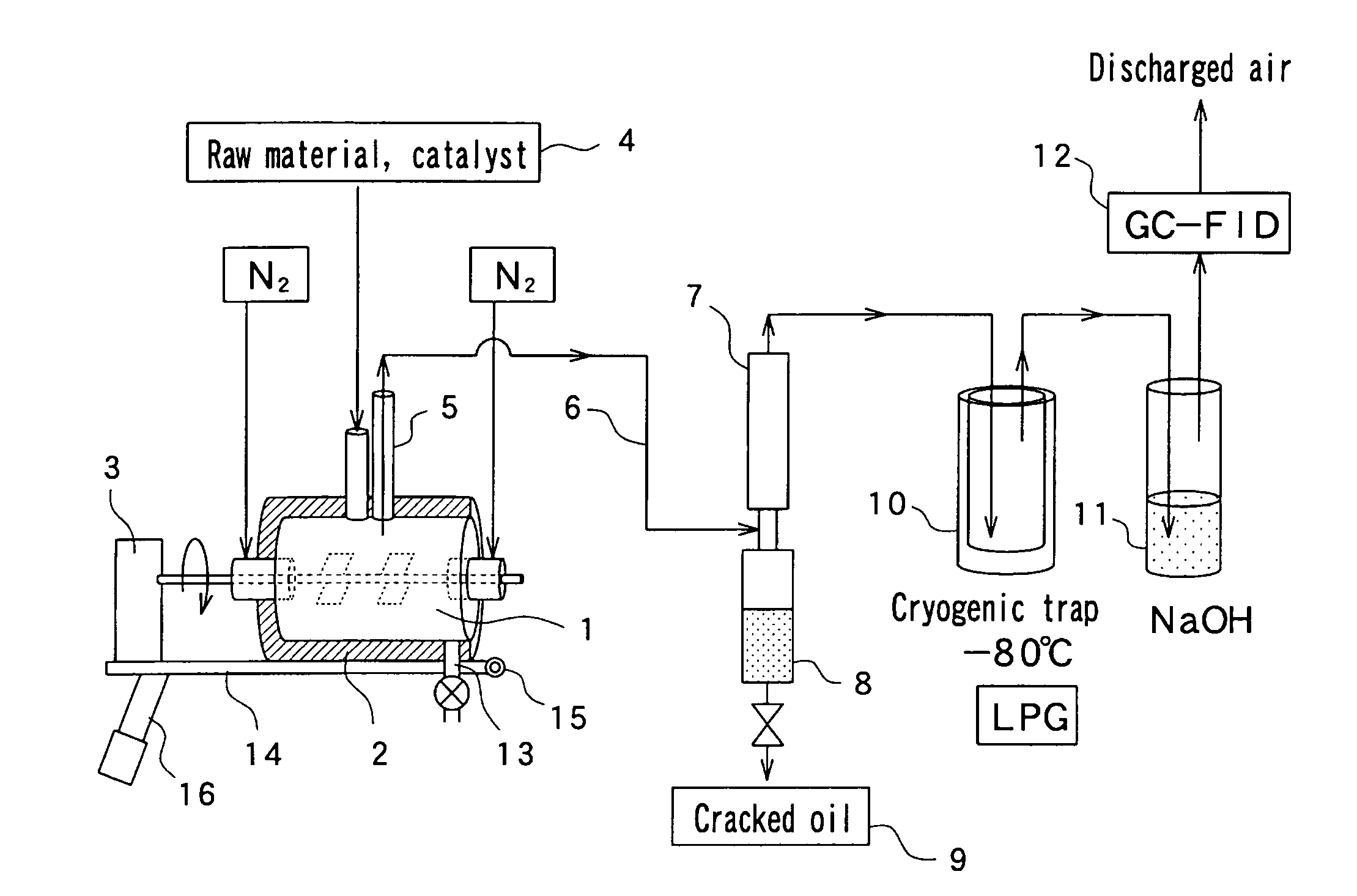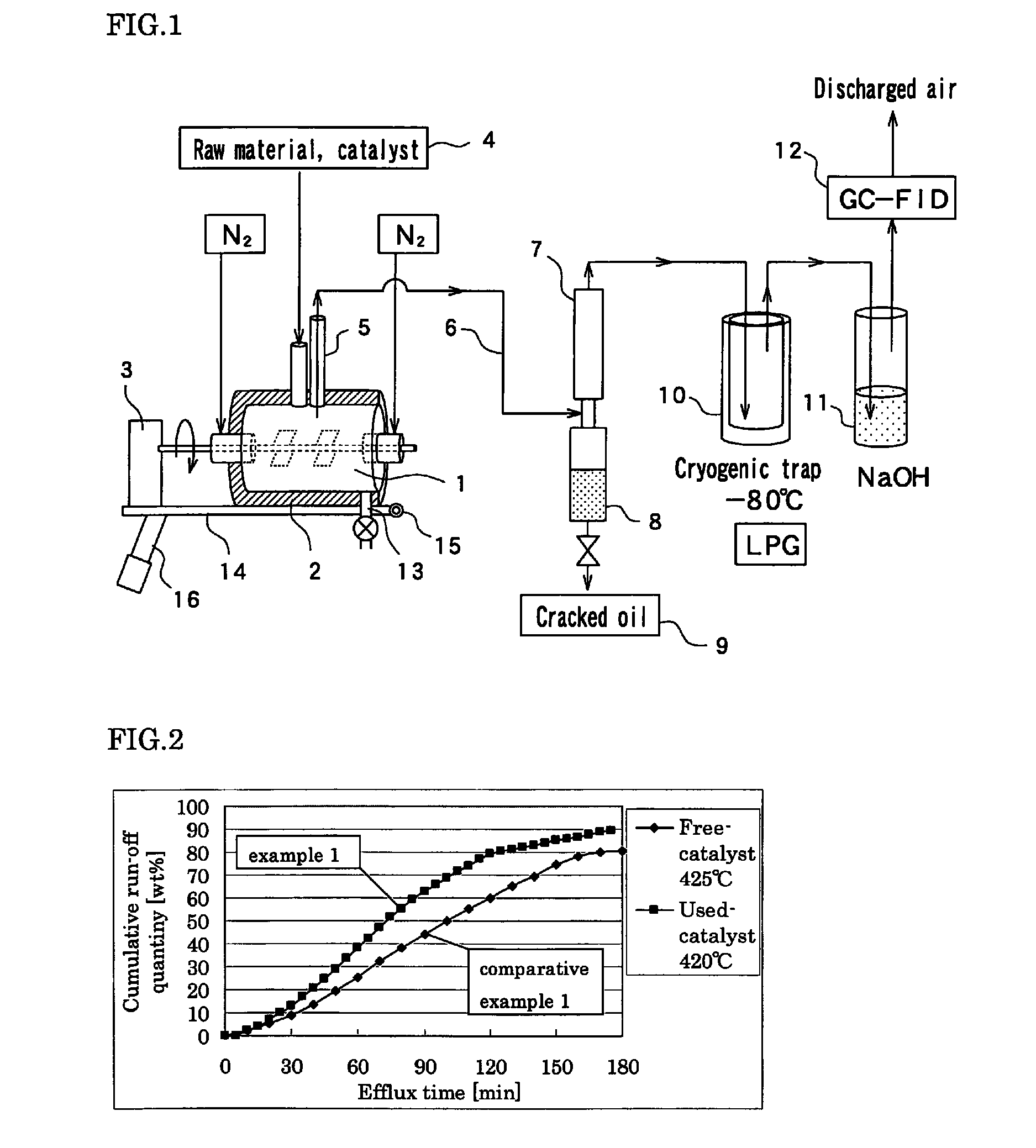Method for catalytically cracking waste plastics and apparatus for catalytically cracking waste plastics
a technology of catalytic cracking and waste plastics, applied in the field of catalytic cracking waste plastics and catalytic cracking apparatus, can solve the problems of complex apparatus structure, high processing cost, poor efficiency of decomposition reaction, etc., and achieve the effect of improving productivity
- Summary
- Abstract
- Description
- Claims
- Application Information
AI Technical Summary
Benefits of technology
Problems solved by technology
Method used
Image
Examples
first embodiment
The First Embodiment
[0185]FIG. 1 is a schematic view of an apparatus for catalytically cracking waste plastics according to the first embodiment of the present invention.
[0186]In FIG. 1, the numeral 1 denotes a horizontal-type reaction vessel shaped in a cylindrical form and having a heater 2 as heating means and a rotary-vane type agitator 3 as agitating means. The heater 2 is used to heat granular FCC waste catalysts loaded from a material port 4 up to a temperature range from 300° C. to 500° C., preferably from 400° C. to 480° C. and more preferably from 410° C. to 430° C. In this embodiment, the heater 2 is such a heater that can be easily controlled for temperatures, for example, an electric heater. Waste plastics which are finely degraded into granules to flakes are loaded into granular FCC waste catalysts heated to a high temperature inside the reaction vessel 1 and mixed and agitated by the agitator 3 to dredge the waste plastics with the high-temperature granular FCC waste ...
experiment 1
[0194]The catalytically cracking apparatus described in the first embodiment 1 is used to carry out the following processes, namely, 10 g of granular FCC waste catalyst is heated to 420° C. by actuating a heater 2 inside a reaction vessel 1, 75 g of granular to flake-shaped polyethylene (PE) is loaded into the high-temperature granular FCC waste catalyst from a material port 4, an agitator 3 is rotated at 50 rpm, the granular FCC waste catalyst is mixed and agitated with granular to flake-shaped polyethylene (PE), the polyethylene (PE) is dredged with the high-temperature granular FCC waste catalyst, thereby facilitating heating / decomposition reactions. The decomposition reaction is set to proceed at 420° C. under an atmospheric pressure. Cracked gas is sent into a cooling mechanism 7, with N2 gas (100 mL / min) being used as a carrier, then, cooled and liquefied to obtain oil fractions.
[0195]FIG. 2 shows a relationship between the efflux time and the cumulative run-off quantity (weig...
experiment 2
[0201]Evaluation is made for a relationship between the efflux time and the cumulative run-off quantity (weight %) of decomposition products, a carbon number distribution of cracked oil and a quantity of cracked gas produced under the conditions the same as those in Experiment 1 except that the reaction temperature is set at three levels, namely, 410° C., 420° C. and 430° C. It is noted that the cumulative run-off quantity (weight %) of decomposition products and the carbon number distribution of cracked oil are determined similarly as in Example 1.
[0202]FIG. 4 shows a relationship between the efflux time and the cumulative run-off quantity (weight %) of decomposition products.
[0203]As apparent from FIG. 4, cracked oil is obtained at a higher yield according to a higher reaction temperature, and the cracked oil flows out at a greater speed. Further, as apparent from FIG. 6, gas is produced at an increased quantity, and decomposition takes place more easily. However, as apparent from...
PUM
| Property | Measurement | Unit |
|---|---|---|
| temperature | aaaaa | aaaaa |
| temperature | aaaaa | aaaaa |
| temperature | aaaaa | aaaaa |
Abstract
Description
Claims
Application Information
 Login to View More
Login to View More - R&D
- Intellectual Property
- Life Sciences
- Materials
- Tech Scout
- Unparalleled Data Quality
- Higher Quality Content
- 60% Fewer Hallucinations
Browse by: Latest US Patents, China's latest patents, Technical Efficacy Thesaurus, Application Domain, Technology Topic, Popular Technical Reports.
© 2025 PatSnap. All rights reserved.Legal|Privacy policy|Modern Slavery Act Transparency Statement|Sitemap|About US| Contact US: help@patsnap.com



